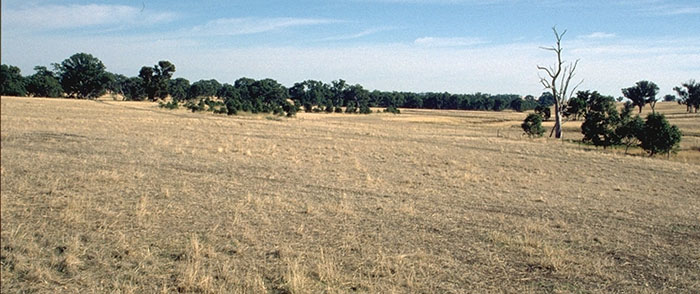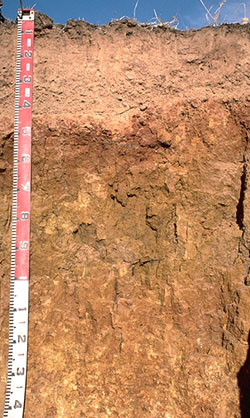LP105
Australian Soil Classification: Vertic and Hypocalcic, Mottled-Subnatric Red SODOSOL
Northocte Factual Key: Dy 3.43
Great Soil Group: Solodic
Site Description: Footslope of sedimentary hill.
Geology: Quaternary alluvium over Ordovician sandstone

Soil Profile Morphology
Surface Soil
| A1 | 0-5 cm | Dark brown (7.5YR3/4); sandy loam; massive structure; weak consistence dry; pH 5.1; abrupt change to: |  LP105 Profile |
| A21 | 5-20 cm | Strong brown (7.5YR4/6); heavy sandy loam; massive; weak consistence dry; common fine alluvial gravel; pH 4.8; clear change to: | |
| A22 | 20-40 cm | Strong brown (7.5YR5/6); heavy sandy loam; massive; weak consistence dry; many medium alluvial gravels; roots to 40 cm; pH 5.7; sharp change to: | |
| Subsoil | |||
| B21 | 40-42 cm | Yellowish red (5YR5/8); light clay; massive; strong consistence dry; pH 6.5; abrupt change to: | |
| B22 | 42-65 cm | Red (2.5YR4/8), with many yellowish brown (10YR5/6) mottles; medium clay; moderate medium blocky structure; very strong consistence dry; pH 6.4; clear change to: | |
| B23 | 65-100 cm | Brownish yellow (10YR6/6); medium clay; weak medium prismatic structure; very strong consistence dry; slickensides evident; pH 7.1; clear change to: | |
| B24 | 100-120 cm | Strong brown (7.5YR5/8), with brownish yellow (10YR6/6) mottles; medium clay; weak medium prismatic structure; very strong consistence dry; very few soft carbonates in patches; slickensides evident; pH 8.5; clear change to: | |
| B25 | 120+ cm | Yellowish red (5YR5/6), with brownish yellow (10YR6/8) mottles; light medium clay; moderate coarse blocky structure, breaking down to strong medium polyhedral structure; very strong consistence dry; pH 8.7. | |
Key Profile Features
- Strong texture contrast between surface (A) and the top subsoil (B21) horizon.
- High content of alluvial gravel in the surface horizons.
- Vertic properties at depths below 65 cm.
Key Profile Characteristics
pH | Salinity Rating | ||
Surface (A1 horizon) | Strongly Acidic | Very Low | Sodic |
Subsoil (B21 horizon) | Slightly Acid | Very Low | Sodic |
Deeper subsoil (85 cm) | Strongly Alkaline | Very Low | Strongly-Sodic |

| The A horizon is moderately acid. The upper B is slightly acid, becoming strongly alkaline at depth. | The salinity rating is very low.
| This profile is sodic, becoming strongly sodic at depth. | Low clay content in the surface, with a sharp increase at the A/B interface. |
Horizon | Horizon Depth (cm) | pH (water) | pH (CaCl2) | EC dS/m | Exch. Al ppm | Organic Carbon % | Exchangeable Cations | Coarse Sand (0.2-2.0 mm) % | Fine Sand (0.02-0.2 mm) % | Silt (0.002-0.02 mm) % | Clay (<0.002 mm) % | Wilting Point % w/w | |||
Ca | Mg | K | Na | ||||||||||||
meq/100g | |||||||||||||||
A1 | 0-5 | 5.1 | 4.3 | 0.13 | 16 | 3.6 | 2.4 | 0.87 | 0.50 | 0.27 | 13 | 54 | 20 | 12 | 5.5 |
A21 | 5-20 | 4.8 | 4.2 | 0.06 | 29 | 0.73 | 0.34 | 0.21 | 0.11 | ||||||
A22 | 20-40 | 5.7 | 4.7 | <0.05 | 0.86 | 0.65 | 0.24 | 0.12 | 17 | 57 | 16 | 10 | 3.1 | ||
B21 | 40-42 | 6.5 | 4.7 | <0.05 | 0.73 | 2.0 | 0.22 | 0.37 | |||||||
B22 | 42-65 | 6.4 | 5.0 | 0.06 | 2.6 | 9.4 | 0.69 | 1.7 | 5 | 15 | 6 | 75 | 22.7 | ||
B23 | 65-100 | 7.1 | 5.9 | 0.08 | 3.1 | 11 | 0.61 | 2.0 | 5 | 23 | 10 | 62 | 19.5 | ||
B24 | 100-120 | 8.5 | 7.2 | 0.13 | 2.4 | 9.3 | 0.35 | 2.3 | |||||||
B25 | 120+ | 8.7 | 7.4 | 0.15 | 2.4 | 9.1 | 0.31 | 2.6 | |||||||
| Management Considerations: Whole Profile
Surface (A) Horizons
Profile Described By: Mark Imhof, Paul Rampant and Karen DePlater, November 1995 |


